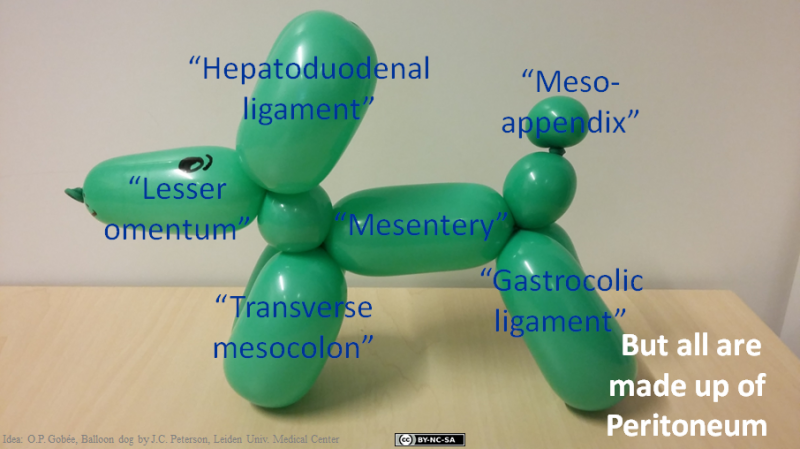 PITFALL
PITFALL
What is 'intraperitoneal'?
 Terminology of the peritoneum: mesenteries, peritoneal ligaments and omenta
Terminology of the peritoneum: mesenteries, peritoneal ligaments and omenta
By O.P. (Paul) Gobée, dept. of Anatomy and Embryology, Leiden University Medical Center, last update: 24 sept 2024
Peritoneum, mesentery, gastrocolic ligament, transverse mesocolon... ouch... all these terms can easily get you confused. But they just are all terms for specific parts of peritoneum. There are three categories of peritoneal formations with specific terms: mesenteries, peritoneal ligaments and omenta. The specific terms are all derivatives of these category terms.
Moreover it can be confusing that a speaker may indicate a part of the peritoneum interchangeably with different terms, dependent on how specific the speaker wants to be. But this is a general phenomenon in language. Just as Jane may be called: a human being, a woman, a Scotswoman, or simply: Jane. Knowing the principles will greatly help you dealing with the terms in usage for the peritoneum and its parts. This video gets you started! (1m54s) 

This article discusses the peritoneal terminology in detail.
Three types of terms are used for parts of the peritoneum:
A mesentery = a double layer of peritoneum, caused by invagination of an organ into the peritoneum, that connects the organ to the body wall and gives pathway to blood vessels, nerves and lymphatic ducts between the organ and the body wall.
Their name is formed by connecting the prefix ‘meso-‘ to the name of the attached organ. If they interconnect two organs, they are named after these both organs. Some have specific names though. Examples:
| Latin term | English equivalent | Is the mesentery of the: |
| mesocolon transversum | transverse mesocolon | transverse colon |
| mesocolon ascendens | ascending mesocolon | ascending colon |
| mesosigmoid | sigmoid mesocolon | sigmoid colon |
| mesoappendix | meso-appendix | appendix |
| mesogastrium | mesogastrium | stomach |
| mesenterium | mesentery | jejunum and ileum |
 PITFALL
PITFALL
The mesentery to the jejunum and ileum does not have a compound term containing jejunum and ileum, but is simply named ‘mesentery’. This leads to a subtle effect in its usage:
A peritoneal ligament = a double layer of peritoneum, that connects an organ with another organ or the body wall. If they interconnect two organs, they are named after these both organs. Some have specific names though.
Examples:
| Latin term | English equivalent | Connects |
| Lig. gastrocolicum | Gastrocolic lig. | Stomach (Gr: ‘gaster’) and colon |
| Lig. gastrosplenicum | Gastrosplenic lig. | Stomach (Gr: ‘gaster’) and spleen |
| Lig. hepatogastricum | Hepatogastric lig. | Liver (Gr: hepar) and stomach (Gr: ‘gaster’) |
| Lig. hepatoduodenale | Hepatoduodenal lig. | Liver (Gr: hepar) and duodenum |
| Lig. splenorenale | Splenorenal lig. | Spleen and kidney (Lat: renis) |
| Lig. falciforme | Falciform lig. | Liver and abdominal wall (Lat: falx:crescent) |
| Lig. coronarium | Coronary lig. | Liver and diaphragm (Its form resembles a crown : corona) |
 PITFALL
PITFALL
‘Ligament’ more commonly means: a strip or band of connective tissue. Examples are: the ligamenta flava that interconnects vertebra, the sacrospinous ligament in the pelvis, etc. In fact, the term ligament is far more often used for structures that are not peritoneum.
An omentum is a double (or multiple) layer of peritoneum from the stomach or the proximal part of the duodenum to adjacent abdominal organs. There are only two of them:
| Latin term | English equivalent | Connects |
| Omentum minus | Lesser omentum | From stomach and proximal duodenum to the liver |
| Omentum majus | Greater omentum | From stomach and proximal duodenum to the transverse colon and transverse mesocolon, and hangs down freely from the transverse mesocolon anterior of the intestines. |
 PITFALL
PITFALL
 View license
View license If you use this item you should credit it as follows:

Comments